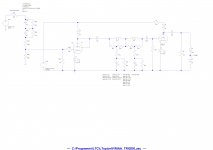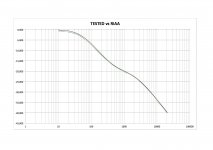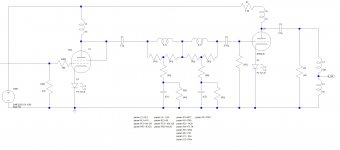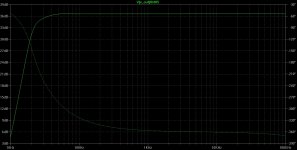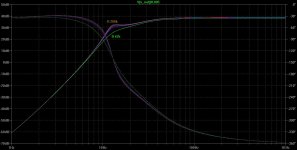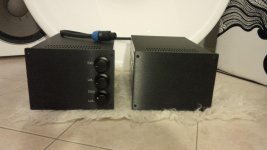My latest (well ... first) RIAA preamp
Folks
this is my first RIAA preamp, now fully working and assembled after one year or more of work. Pretty much satisfied with the results and the sound. I will be posting pics and other info slooooowly.
It sports a 10x step up, a triode strapped D3a, a high impedance LCR network (Dave Slagle's irons) and a ECC88 output stage into a tapped autoformer. Tubes are choke loaded and biased by a LED. Gain is 38.5dB at 1kHz (without 10x input transformer, attenuated at the output by the autoformer) and RIAA accuracy is within 0.2dB.
Power supply is 6X5GT into a LCRC filter + a Salas Shunt regulator.
Parts: D3a are siemens and E88CC err... I don't remember, caps are WIMA film+foil for the RIAA and solen/mundorf interstage, all irons are from Dave Slagles (nickel cores), cheap red LED, motor run caps in the power supply ... well, nothing really fancy except the inductors. The schematics itself is nothing new either but it works really good.
Attached: schematics (NB: inverse RIAA network at the input and no step up) and RIAA measured for both channel
Folks
this is my first RIAA preamp, now fully working and assembled after one year or more of work. Pretty much satisfied with the results and the sound. I will be posting pics and other info slooooowly.
It sports a 10x step up, a triode strapped D3a, a high impedance LCR network (Dave Slagle's irons) and a ECC88 output stage into a tapped autoformer. Tubes are choke loaded and biased by a LED. Gain is 38.5dB at 1kHz (without 10x input transformer, attenuated at the output by the autoformer) and RIAA accuracy is within 0.2dB.
Power supply is 6X5GT into a LCRC filter + a Salas Shunt regulator.
Parts: D3a are siemens and E88CC err... I don't remember, caps are WIMA film+foil for the RIAA and solen/mundorf interstage, all irons are from Dave Slagles (nickel cores), cheap red LED, motor run caps in the power supply ... well, nothing really fancy except the inductors. The schematics itself is nothing new either but it works really good.
Attached: schematics (NB: inverse RIAA network at the input and no step up) and RIAA measured for both channel
Attachments
Last edited:
I can't read the schematic. The lines are too faint. is there some way you can make it darker or bigger?
It is actually a high resolution pic, you can click on it and zoom into it.
It's absolutely unreadable.
My method:
LTSpice->Tools->Copy bitmap to Clipboard---->IrfanView (or other program)->Paste (CTRL-V)->File->Save as (something.pjg).
These pictures are well readable.
No problem here looking at the schematic.
There is a good way to do RIAA inverse EQ using the Laplace Transform, if you search on some of my projects in analog source you should be able to find the equation and the symbol used.
There is a good way to do RIAA inverse EQ using the Laplace Transform, if you search on some of my projects in analog source you should be able to find the equation and the symbol used.
I had no problem zooming the original schematic, but your hint did help! 🙂
I have built a few different RIAA, and always use some kind of follower at the last stage if I plan to use an interconnect.
Ian
I have built a few different RIAA, and always use some kind of follower at the last stage if I plan to use an interconnect.
Ian
Hey Ian, you are spot on. I considered a follower for long time and at the end I decided for the stepped autoformer at the output. Performance-wise a cathode follower would be excellent and cheaper but I needed some kind of volume control and didn't want to have that extra tube.
The 38.5dB gain I mentioned was after a 6dB attenuation at the autoformer so impedance at the output is also greatly reduced while you reduce volume.
And, that's a bit tricky, that output stage is a resonant cell (Loading choke, cap, autoformer) that when properly sized can run flat down to 20Hz and drop at subsonic frequencies which clearly is good in a pre-phono. The parafeed arrangement is to be investigated and tuned experimenttaly to avoid nasty subsonic resonances.
Attached the freq response (simulated, with anti-RIAA at the input), as you see frequency drops at 30Hz and slope gets steeper below 20Hz. In my pre I had to increase the output capacitor C3 to 0.47uF (vs 0.3uF in the schematics) and got a nice flat bandwidth down to 20Hz with no subsonic peaks. The 47k R2 resistor plays a role too as it 'dampens' the resonance. A couple simulations for different values attached.
You don't get this free subsonic filter with follower.
The 38.5dB gain I mentioned was after a 6dB attenuation at the autoformer so impedance at the output is also greatly reduced while you reduce volume.
And, that's a bit tricky, that output stage is a resonant cell (Loading choke, cap, autoformer) that when properly sized can run flat down to 20Hz and drop at subsonic frequencies which clearly is good in a pre-phono. The parafeed arrangement is to be investigated and tuned experimenttaly to avoid nasty subsonic resonances.
Attached the freq response (simulated, with anti-RIAA at the input), as you see frequency drops at 30Hz and slope gets steeper below 20Hz. In my pre I had to increase the output capacitor C3 to 0.47uF (vs 0.3uF in the schematics) and got a nice flat bandwidth down to 20Hz with no subsonic peaks. The 47k R2 resistor plays a role too as it 'dampens' the resonance. A couple simulations for different values attached.
You don't get this free subsonic filter with follower.
Attachments
A pic. It has been playing for several months and I am super happy! Noise is 0.1mVrms at 50+100Hz that is -72dB below the output with a typical 5mV cartridge.
I am using a 10x step up for MC, noise raises to 0.2mVrms as the transformer is not screened but moving the signal chassis away from the PSU it gets down to 0.1mVrms. I'll have to find a mu metal can for it.
I am using a 10x step up for MC, noise raises to 0.2mVrms as the transformer is not screened but moving the signal chassis away from the PSU it gets down to 0.1mVrms. I'll have to find a mu metal can for it.
Attachments
A pic. It has been playing for several months and I am super happy! Noise is 0.1mVrms at 50+100Hz that is -72dB below the output with a typical 5mV cartridge.
I am using a 10x step up for MC, noise raises to 0.2mVrms as the transformer is not screened but moving the signal chassis away from the PSU it gets down to 0.1mVrms. I'll have to find a mu metal can for it.
Nice work! 🙂
Calculate the output impendence...
that will be lower than 600ohm and much lower as you attenuate through the output autotransformer
it works fine on my mac.
Nice implementaion of Inductors
It should drive up to 8 feet of good quality cable easily
Nice implementaion of Inductors
It should drive up to 8 feet of good quality cable easily
Last edited:
- Status
- Not open for further replies.
- Home
- Amplifiers
- Tubes / Valves
- My latests (well ... first) RIAA preamp
